What’s Hiding in Your Food?
How food companies have changed based on consumers responses
A couple of decades ago, shopping was as simple as picking up a product and, if it’s appetizing, buying it. Although, nowadays it’s much more complicated than that. Today, when a person goes to the grocery store and picks up a product, they have to look at the ingredients and see if it’s organic or determine if there are harmful chemicals in it. If they don’t do this, then they risk buying something that could potentially be harmful to their bodies.
When we look at what foods are ‘good foods’ the word ‘organic’ normally comes to mind, and for the most part, this is true. If a product is 100% organic it’s good for the consumer. Although if a product says “made with organic,” then it is most likely only 70% organic materials. This means that that 70% has no harmful substances in it like, chemicals, additives, pesticides, or substances that were genetically-engineered. But, the other 30% could contain any of those elements.
Some products that people should always try and buy as 100% organic are products like beef, milk, berries, or anything with tomatoes.
With these genetically-engineered substances and additive ingredients in the food, it’s no wonder society doesn’t trust what companies are telling them about their products. According to a survey done by the market research firm Mintel, only 38% said that they trusted what companies were saying about their food products. That means the vast majority, 62%, said they don’t.
Since the majority of people don’t trust companies, the companies have begun to fight back. They have started to label products less as a chemist would name them and more of how a cook would name them. Companies have also started to make ingredient lists short and sweet, meaning that they have made them easier to pronounce and understand for the consumer.
This altering of product marketing is called clean labeling and more and more companies have hopped on board with it. It has caused some companies to take out their artificial coloring in their products and create more ‘healthy’ items, which benefits the consumer and the companies themselves.

Tymber Moody is a senior, and this is her third year on the newspaper staff. She is also this year’s web editor. Tymber is currently a tumbling...




